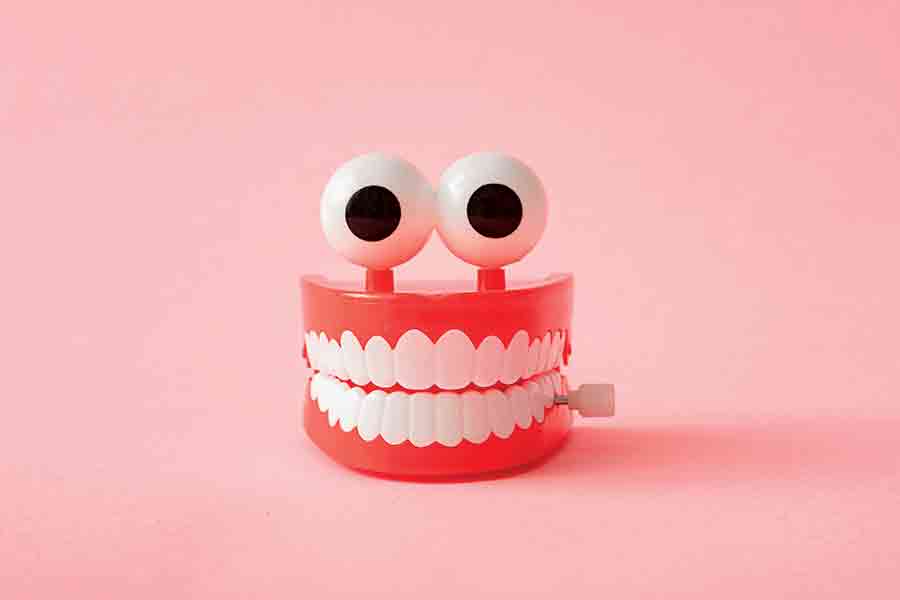Philly’s Top Dentists on the Sneaky Signs of Gum Recession
How those pink, fleshy gums play a surprisingly important role in dental health

We talked to a handful of our Top Dentists about something that can affect all of us: gum recession. / Photograph by Zamurovic Brothers/Shutterstock
We all have firsthand experience with teeth. We use these little white chiclets all day long: chewing, smiling — and what other part of our body do we care for twice a day, every day? We spend so much time with our teeth, but do we really understand them?
Poke around on the internet for simple explanations and you’ll likely come up lacking. What are the roots and where are they, and what exactly are our gums? It’s surprisingly tough to wrap your mind around what’s happening in this part of the body we all think we know so well. (It’s not, like, the gallbladder. What’s going on there?) So to get to the root of the matter, we talked to a handful of our Top Dentists about something that can affect all of us: gum recession.
First, we all need a little anatomy lesson.
A tooth has two parts: The top, or crown, is the part we see when we smile. Enamel, which is the white part, covers and protects the tooth. Below this is the bottom half of the tooth, the root. It’s yellow and, unlike the crown, does not have the protective enamel coating. It does, however, have its own protection: the gum. This is the pink, fleshy tissue that surrounds the roots of the teeth. Unlike the rest of the tissue in your mouth, which is more cherry red, gum tissue should be pink and soft. The gums work with the bones in our mouth to hold the teeth in place and protect the roots because they don’t have the extra protection of the enamel. Dmitriy Klass, a periodontist (a dentist who specializes in the treatment of gum disease) in Northeast Philly, compares the root of a tooth to the roots of a tree: “Just like a tree has roots in the ground and the soil keeps the tree from swaying too much, a tooth has its roots covered by gum.” In fact, if your mouth is healthy, you should never see the roots of your teeth.
So, what is gum recession, and what causes it?
Leave it to an expert to simplify things: Center City periodontist Ishita Bhavsar explains that recession is when the gum tissue around your teeth moves downward, exposing more of the root of the tooth. This, she says, can lead to sensitivity and discomfort and, if not treated, can compromise the health of the tooth.
Some of us are genetically predisposed to gum recession. Our gums are already thin, and as our teeth naturally shift, the gum pulls away from the root. Daniel Kubikian, a periodontist in Sewell, offers another great metaphor: Visualize a woman at the start of her pregnancy wearing a form-fitting t-shirt. “Imagine her keeping that shirt on as she goes through pregnancy,” he says. “As the belly grows it pushes the shirt out and then it rises up, revealing the belly.” That’s what happens to a tooth. If our gums are thin in one area and a tooth is naturally moving, the gum gets to a point where it cannot thin anymore and so begins to rise up (or down for bottom teeth), revealing the root.
For the rest of us, gum recession is caused by trauma (for example, tongue rings or brushing too aggressively), poor hygiene, or positioning. Bhavsar says the most common cause of gum recession is poor home care, when you aren’t able to target certain areas and then the plaque collects in that location. “It becomes an inflammatory process where gum tissue is constantly irritated by bacteria, resulting in gum recession,” she says. Kubikian sees anatomy as another common problem. “One of the main causes of gum recession is if the mouth is too small to contain all of the teeth. As a result, some or all of the teeth will begin to protrude.” This might be something you will be unable to see, he notes, but a dentist can tell if it’s causing the gums to recede.
Other risk factors? Diabetes and smoking. So drop the drags.
Does it hurt?
Most of the time, gum recession doesn’t hurt. When the root is initially exposed, you may feel sensitivity to cold, or even a zap of pain. But Kubikian explains that we can quickly get used to this, and, by the time we’re told we have gum recession, we may not even remember having any discomfort.
Yikes! I have gum recession — now what?
First, see a periodontist. Then, consider your options. Some people have only mild gum recession that can be treated at home with better hygiene. Others may have issues with the position of their teeth; they can have orthodontic treatment to move misaligned teeth back into position and relieve pressure on the gums. And finally, gum surgery is an option.
Gum surgery, double yikes!
Unfortunately, there are no fast and easy solutions for gum recession. Yes, you can reposition a tooth or improve your hygiene, but often gum grafting is the best option. If a patient doesn’t have at least two millimeters of gum, Bhavsar says, the periodontist will take tissue from the roof of the mouth and sew or graft it onto the gum. The two primary goals of grafting are to increase the thickness of the gum and to re-cover part of the root, according to Kubikian.
This may sound daunting, but it doesn’t have to be. Most patients have pain in the spot the tissue is taken from. (Some patients compare it to burning the top of your mouth with pizza.) Pain is common for the first two to three days and typically decreases steadily over the next week, Bhavsar says. And your dentist will provide you with a palate protector to help with discomfort.
A word on orthodontia.
Orthodontia — meaning braces or clear aligners (think Invisalign) — can both fix and cause gum recession. When preteens and teens get braces to create ample space for all of their teeth, this should prevent gum disease, but sometimes, especially if the gums are already thin, this movement can actually contribute to gum recession.
Conversely, correcting teeth that are out of position with braces is one recommended treatment for gum recession. Getting teeth back into position helps the gum to come back over the root. While gum recession is not a disease of old age, as we get older our teeth continue to move forward, which may cause recession. (That’s one reason you may see your 50-something neighbors suddenly donning clear aligners despite seemingly straight teeth.)
A quick word about kids and gum recession. With children, gum recession is all about proper hygiene. And while orthodontic treatment or misaligned teeth can contribute to gum recession, good hygiene can make up for normal changes in children’s teeth, says Elena Stavisky, a pediatric dentist in Haddon Township: “A high percentage of the cases are preventable with just good home care.” She often asks parents to brush their children’s teeth until they can do it properly on their own.
So, what can I do?
This is one time when an ounce of prevention truly can make a difference in your mouth health. Careful hygiene, including brushing twice daily with a soft- or medium-bristle electric toothbrush and flossing, helps to stimulate your gums and keep them healthy, thick, and pink. But be careful — aggressive brushing is a common cause of gum recession.
Brushing 101
Every dentist we spoke with emphasized the importance of good hygiene in preventing and managing gum recession. Periodontist Dmitriy Klass admits that this is not as easy as you might think: “I really learned how to brush my teeth properly when I went to dental school.” He recommends first asking your dental hygienist how to best clean your particular set of teeth. Then use a manual or electric toothbrush with a soft-bristle head and just the tiniest bit of paste — think a grain of rice for kids, a pea for adults. (He also suggests a short YouTube video on the American Dental Association’s recommended toothbrushing method, which you can helpfully watch while brushing your teeth.) Here are the basics of this technique to help you get your smile sparkling and your gums pink and healthy.
1. Hold the toothbrush between your thumb and forefinger.
2. Position the bristles at a 45-degree angle to your teeth.
3. Brush two or three teeth at a time (the size of a normal toothbrush head) in a gentle back-and-forth motion. It’s okay to make this slightly circular.
4. Now here’s the important part: Before moving on to the next few teeth, flick the brush (and any hidden plaque) away from the gums.
Published as “What the Heck Is Gum Recession?” in the March 2025 issue of Philadelphia magazine.


